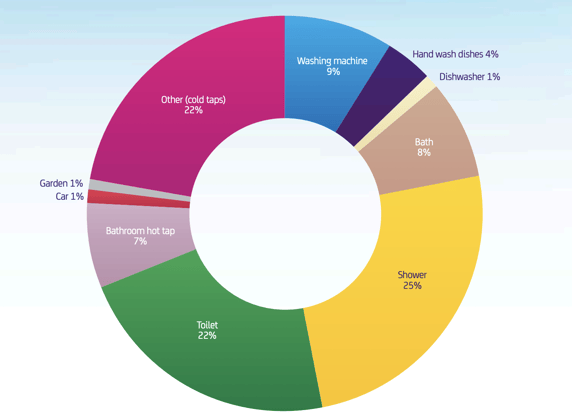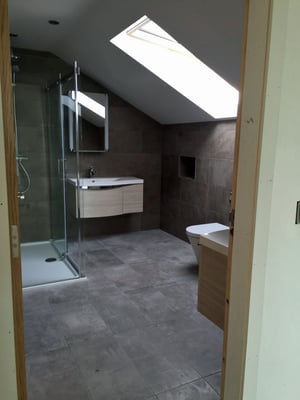The self-build industry has its sustainability spotlight on heating and energy efficiency, but being water-wise can sometimes swim under the radar.
Managing your water consumption might not be the most glamorous aspect of the self-build process, but its importance cannot be overstated. Efficient water management helps to reduce your impact on the environment and your future utility bills.
When it comes to water management, every drop counts! This article will give you everything you need to know about the best water management strategies for your self-build home.
WHAT DOES WATER EFFICIENCY MEAN?
A water-efficient home is one that is designed, constructed, and equipped to use water more sparingly and effectively. This involves implementing various strategies and technologies to reduce water consumption.
A water-efficient home strives to minimise your daily water consumption by reducing your water waste and promoting sustainable water management practices.
If your self-build is in England, you must carry out a water efficiency calculation to ensure your building complies with building regulations and is truly water-efficient.
Luckily, our famous British weather gives us a reliable source of rainwater to use in our home, but that doesn’t negate the fact that water is a precious resource, and being smart with our water can lessen our environmental impact.
Being truly water-efficient isn’t just how we design our home. It’s a combination of thought-out design fixtures and water-saving strategies we can practice in our daily routine. Let’s look at essential strategies to navigate water management as a self-builder.
DESIGNING A WATER EFFICIENT SELF BUILD
From the early stages of the design process, you should start thinking about how your design is going to be water-efficient. Consider Implementing strategies such as orientating the building for natural cooling and heating, as well as efficient plumbing layouts to minimise the length of pipe runs. Your architect/technologist will assist you in this.
Many of our clients at AC Architects install a rainwater collection system to capture and store rainwater from roofs for uses such as garden irrigation, flushing toilets, and washing machines. You must ensure that the system is designed and sized appropriately for the uses you require, which is why it’s so important to have early conversations with your architect/technologist about what water harvesting systems you require. It can also sometimes be a requirement of the local authority/Water board that the amount of water being discharged into the public sewer is reduced by using this measure.
These rainwater harvesting systems come at a steep cost, so the benefits to both budget and the environment must be considered carefully before progressing with this strategy.

When looking for water-efficient appliances, you’ll be introduced to low-flow fixtures. These are modern fixtures that use less water than their original counterparts. These can include toilets, taps and showers. Fixtures that use more water can also be used, and then fitted with flow restrictors by your plumber if this is necessary to meet the water efficiency requirements.
When it comes to recycling the water you use, it’s important to know the differences in how water is used in different rooms of your home. Greywater (wastewater from non-toilet plumbing systems) may not be safe for consumption but can be recycled for use in your garden. Water from your kitchen sink can contain contaminants such as oil and grease, so it might be best to avoid using it.
Externally, water recycling systems are a low-maintenance way to save water throughout the day. A water harvesting tank can take water from toilet flushing, showering and washing machines as well as the roof and reuse it for direct irrigation.
WATER SAVING PRACTICES AT HOME
When the time comes to move into your new home, it’s important to keep your focus on saving as much water as you can. Little changes in your day-to-day routine can drastically cut your water usage, which in turn reduces your utility bills.
When the time comes to move into your new home, it’s important to keep your focus on saving as much water as you can. Little changes in your day-to-day routine can drastically cut your water usage, which in turn reduces your utility bills.
Simple changes such as running full loads in your washing machine, turning off taps while brushing your teeth and taking quicker showers can make a substantial difference in your daily water consumption.

The bathroom in general is a great place to start when looking to cut down on your water use. The Energy Saving Trust estimates that over 60% of household water consumption occurs in the bathroom.
Think about saving water in your garden too. Excessive hosepipe use and unnecessary watering can lead to a lot of water waste.
There are very few plants that will die without artificial watering (this includes your grass), so there is no harm in letting them turn brown in the colder months.
Saving water in your home should be a team effort. Make sure any other occupants are changing their habits too!
CONSIDER YOUR DRAINAGE SYSTEM
When it comes to managing your water efficiently, you’ll find it takes more than taking a shorter shower. We need to think about what’s going on underground.
A well-designed drainage system is essential for preventing flooding, protecting property and infrastructure, preserving water quality, and enhancing the landscape of urban and rural areas.
Sustainable surface water drainage is also known as sustainable urban drainage systems (SuDS). It is a term used to define the process of managing surface water runoff in urban areas in order to have as little impact as possible on flooding, water quality and nature as possible.
One of the primary functions of a drainage system is to protect the structural integrity of your home. Water, whether from rainfall or melting snow, can wreak havoc if not properly managed. Water accumulating around the foundations can lead to structural instability over time. A well-designed drainage system should direct water away from the foundation.
For individual dwellings, soakaways are used wherever possible for surface water. These are essentially crates put in the ground into which flows excess rainfall which is gradually released into the ground around it. They are a great way to relieve pressure from your main drainage system but come with installation and product costs. Fortunately, these can be straightforward to retrofit. Unfortunately, these are not always possible due to the type of ground that the house is built on.
A civil engineer will design the external drainage system for a home, ensuring that the system is suitable for the levels, ground type and eventual discharge point. Your architect/technologist will be the one designing the drainage within the home.
OUR ROLE IN BUILDING WATER EFFICIENT HOMES
AC Architects regularly include water harvesting tanks, water butts, and soakaways in our projects as they are proven and effective water-saving methods. If your project lies in an area of the country where water consumption is linked to your water bill, the incentive for building a water-efficient home is self-explanatory.
Self-builders have a unique opportunity to integrate sustainable water management practices into their homes from the ground up. Incorporating these water-efficient fixtures in your home will help you build a sustainable home that saves you money and saves the planet, one drop at a time.



